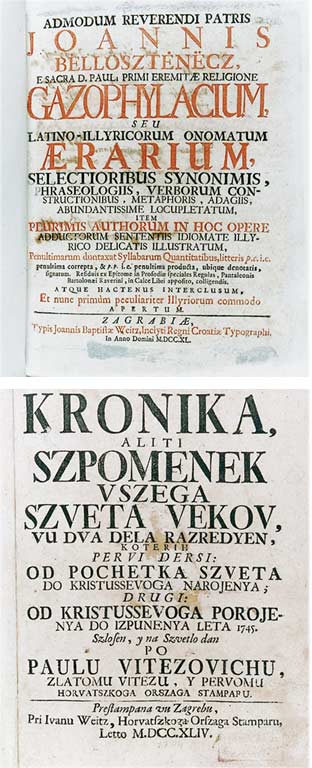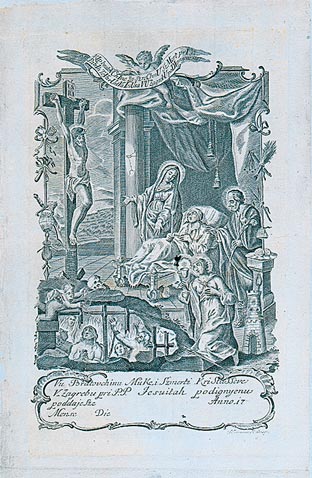Permanent Display 21. Religious Orders Encourage Piety and Education
 The inhabitants of Gradec entered the 17th century with rather modest understanding of spiritual life and religion. Members of religious orders were therefore invited to the town to offer Pabulum spirituale, spiritual nourishment through their sermons, develop education and enhance social life by bringing the townspeople together in fraternities and processions. The spoken and written word had to be nurtured and the native tongue promoted - although the language of instruction was Latin.
The inhabitants of Gradec entered the 17th century with rather modest understanding of spiritual life and religion. Members of religious orders were therefore invited to the town to offer Pabulum spirituale, spiritual nourishment through their sermons, develop education and enhance social life by bringing the townspeople together in fraternities and processions. The spoken and written word had to be nurtured and the native tongue promoted - although the language of instruction was Latin.
The first to arrive at the invitation of the town council were the Jesuits - members of the recently founded Society of Jesus. They were followed by the Capuchins, after whom, at the invitation of the nobility, the Poor Clares came. They were invited in order to provide elementary education, including instruction in music, for young girls.
It was a period of great social change and building development. The town no longer needed defense walls - on their foundations the first large complexes of monasteries and convents with churches were built. The Jesuits were building in the south-east, the Capuchins in the south-west, the Poor Clares in the north-east of the town. With this territorial division the town retained its medieval shape - that of an irregular triangle.
 All the monasteries had rich libraries; the Jesuits had a printing-house, in which the Lexicon, the big Latin-Croatian dictionary by the friar Andrija Jambrešić, was printed in 1742. Two years earlier, in 1740, the National Printing-House at Gradec published Gazophylacium, the a milestone in Croatian lexicography by the Paulist Ivan Belostenec. Both books contain an interesting description of Zagreb. In the 18th century, books with a religious content enjoyed the greatest popularity. Most of them were written by friars - Jesuits, Paulists and Capuchins - who exhorted their readers to love God, their neighbour and their country.
All the monasteries had rich libraries; the Jesuits had a printing-house, in which the Lexicon, the big Latin-Croatian dictionary by the friar Andrija Jambrešić, was printed in 1742. Two years earlier, in 1740, the National Printing-House at Gradec published Gazophylacium, the a milestone in Croatian lexicography by the Paulist Ivan Belostenec. Both books contain an interesting description of Zagreb. In the 18th century, books with a religious content enjoyed the greatest popularity. Most of them were written by friars - Jesuits, Paulists and Capuchins - who exhorted their readers to love God, their neighbour and their country.
Books are printed as early as the 17th century
Encouraged by the friendly invitation of Bishop Aleksandar Mikulić, in 1690 Pavao Ritter (his surname was Croatized by himself as Vitezović), a many-sided writer with a fine education and a broad European outlook, arrived in the Croatian capital. Thus Zagreb gained its first printer. In the same year the first book was printed, "Sermo funebris, To, jeszt shalosno govorenje", of Canon Pavao Antun Češković, written in Croatian, but in the Kaikavian dialect.
Then came a resolution of the Parliament to set up a National Printer in Zagreb. In 1694, Vitezović was given the status of the first printer of the famous Kingdom of Croatia. In his printed works, which ranged from trivial matters of the moment to weighty works of history, he stressed that they came "ex museo meo Graecomonti". Many books saw the light of day in Vitezović's printing house, for example the first "Kalendarium za letto 1695", "Kronika", meant for a wide reading public, and the translation of the book "Sobotnji kinč", ordered by Countess Marija Magdalena Drašković, who promoted Croatian book writing. It was through Vitezović's mediation that Bishop Mikulić bought up the great library of Janez Waichard Valvasor. In 1692, alongside the modest Bishop's Palace, Mikulić had the first library building constructed; it was called the Bibliotheca Metropolitana.
 The society of Jesus on Grič
The society of Jesus on Grič
Thanks to the work of the members of the Society of Jesus, the religious and educational life of the royal city of Zagreb made great strides in the 17th and 18th centuries. In 1607, instruction began in the first Classical Gymnasium or grammar school, with 300 youths as pupils. In the middle of the century, in a new, bigger building, a public Academy was opened for the study of law and philosophy; it was granted the rights and privileges of a University in 1669. For the many youths enrolled a seminary for pupils was opened, called St Joseph's, a monumental three storey building. There were theatrical peformances here as well, among the first in Zagreb. Alongside the monastery, which was constantly expanding, the Jesuits built the Academic Church od St Katarina. They taught the members of the fraternities about life in this world and the next, and the benighted peasantry from the region of Svetoduško were taught religion and a good and model life in this world. At the foot of the Zagreb hills, on the site of the general refuge of the troubled, they built the famed pilgrimage site of St Francis Xavier, renowned for miraculous hearings. Processions set off from the Jesuits' church on Gradec, and, heading over Kaptol, came to Ksaver (Xavier). The people of Zagreb felt such a debt of gratitude to St Francis Xavier that in 1762 he was proclaimed Patron Saint of the city. Abolished in 1773, the Society of Jesus left Zagreb.
Željka Kolveshi

